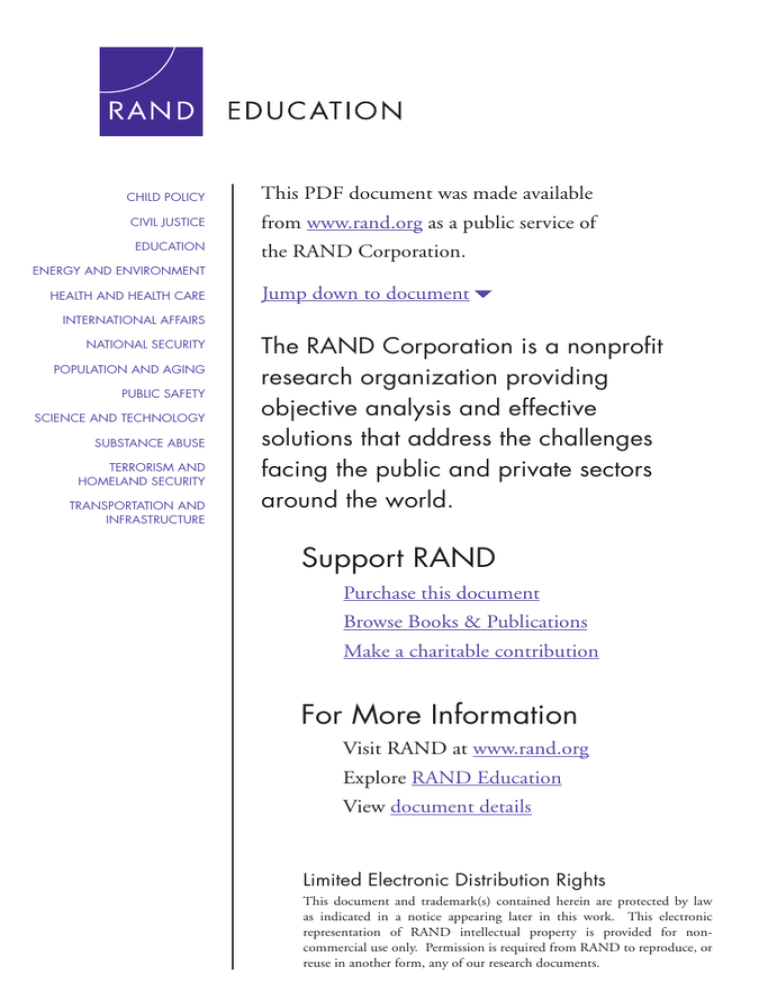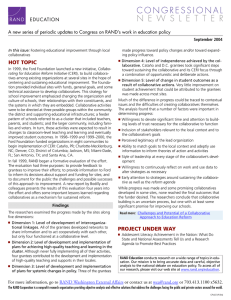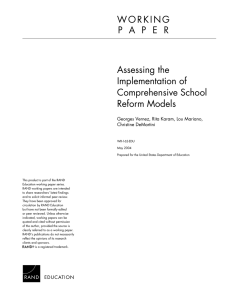
CHILD POLICY
This PDF document was made available
CIVIL JUSTICE
from www.rand.org as a public service of
EDUCATION
the RAND Corporation.
ENERGY AND ENVIRONMENT
HEALTH AND HEALTH CARE
Jump down to document6
INTERNATIONAL AFFAIRS
NATIONAL SECURITY
POPULATION AND AGING
PUBLIC SAFETY
SCIENCE AND TECHNOLOGY
SUBSTANCE ABUSE
TERRORISM AND
HOMELAND SECURITY
TRANSPORTATION AND
INFRASTRUCTURE
The RAND Corporation is a nonprofit
research organization providing
objective analysis and effective
solutions that address the challenges
facing the public and private sectors
around the world.
Support RAND
Purchase this document
Browse Books & Publications
Make a charitable contribution
For More Information
Visit RAND at www.rand.org
Explore RAND Education
View document details
Limited Electronic Distribution Rights
This document and trademark(s) contained herein are protected by law
as indicated in a notice appearing later in this work. This electronic
representation of RAND intellectual property is provided for noncommercial use only. Permission is required from RAND to reproduce, or
reuse in another form, any of our research documents.
This product is part of the RAND Corporation monograph series.
RAND monographs present major research findings that address the
challenges facing the public and private sectors. All RAND monographs undergo rigorous peer review to ensure high standards for
research quality and objectivity.
Challenges and
Potential of a
Collaborative
Approach to
Education Reform
Susan J. Bodilly
Joan Chun
Gina Ikemoto
Sue Stockly
Prepared for the Ford Foundation
The research described in this report was conducted by RAND
Education for the Ford Foundation.
Library of Congress Cataloging-in-Publication Data
Challenges and potential of a collaborative approach to education reform / Susan Bodilly
... [et al.].
p. cm.
“MG-216.”
Includes bibliographical references.
ISBN 0-8330-3652-1 (pbk.)
1. School improvement programs—United States—Case studies. 2. Community
and school—United States—Case studies. 3. Education, Urban—United States—Case
studies. 4. Collaborating for Education Reform Initiative. I. Bodilly, Susan J. II. Rand
Corporation.
LB2822.82.C397 2004
371.2'00973—dc22
2004012847
The RAND Corporation is a nonprofit research organization providing
objective analysis and effective solutions that address the challenges
facing the public and private sectors around the world. RAND’s
publications do not necessarily reflect the opinions of its research clients
and sponsors.
R® is a registered trademark.
© Copyright 2004 RAND Corporation
All rights reserved. No part of this book may be reproduced in any
form by any electronic or mechanical means (including photocopying,
recording, or information storage and retrieval) without permission in
writing from RAND.
Published 2004 by the RAND Corporation
1700 Main Street, P.O. Box 2138, Santa Monica, CA 90407-2138
1200 South Hayes Street, Arlington, VA 22202-5050
201 North Craig Street, Suite 202, Pittsburgh, PA 15213-1516
RAND URL: http://www.rand.org/
To order RAND documents or to obtain additional information, contact
Distribution Services: Telephone: (310) 451-7002;
Fax: (310) 451-6915; Email: order@rand.org
Summary
This report documents a formative evaluation of an effort begun by
the Ford Foundation to develop collaboratives in eight urban centers
from fall 1999 to spring 2003. The effort continues to evolve today.
Collaborating for Education Reform Initiative
After years of attempting to improve education outcomes for all students and not seeing the fully desired results, the Ford Foundation
had become frustrated with traditional approaches to reform.
Through internal discussions and examination of other initiatives, the
foundation staff became convinced that specific sites could make
quality teaching in all classrooms a reality by employing a combination of tactics, such as effectively linking the different levels of preK–12 to higher-education systems; promoting informed public dialog, debate, and consensus-building around school reform options;
promoting professional development for faculty, staff, and administrators; promoting district and state policy changes; and enhancing
the role of parents and caregivers. This strategy for school improvement emphasized changing the organization and culture of schools,
their relationships with their stakeholders, and the systems in which
they are embedded. The Ford sponsors believed that the more coherent, steady, and coordinated these multiple approaches were, the
more likely they were to succeed where other disjointed or discontinuous efforts had failed.
xv
xvi
Challenges and Potential of a Collaborative Approach to Education Reform
The Ford Foundation translated this belief into a strategy for
reform: local collaboration. This philosophy grew out of, in part,
sharing lessons from other foundations’ experiences with collaborative
efforts including the Annenberg Challenge Grants and the Pew
Charitable Trust’s Systemic Initiative. But, it was also a result of the
Ford Foundation’s own previous efforts at collaborative formation
supported from 1991 to 2000 called the Urban Partnership Program
(UPP).
Based on its own experiences with the UPP initiative and
knowledge of other reform efforts, the Ford Foundation chose to
encourage the development of collaboratives of community-based
organizations in urban settings to address systemic barriers to highquality teaching and learning. By basing the impetus for reform
largely outside of the public school central office, the Ford Foundation hoped to avoid the pattern of failure of reforms that originated
solely from the central office and were led by a “transformational,”
and often brief-tenured, superintendent. These internal efforts often
dissipated when district leadership turned over. Ford envisioned collaboratives with multiple member organizations that could outlive the
administrations of public officials. Furthermore, Ford hoped that
collaborative supported reforms would also potentially avoid the failures associated with internally mandated reforms that are not supported by the community or by school personnel. By working from
the outside inward and by involving school staff in planning and constructing the interventions, Ford sponsors hoped that buy-in and
commitment to reform efforts would increase.
Thus the foundation began a new initiative, called the Collaborating for Education Reform Initiative (CERI), by issuing a series of
planning grants in July 1999. As stated in the request for proposals
(RFP), “system-wide reform efforts require effective coalitions among
organizations which are committed to systemic educational reform
over an extended period of time and who project their efforts to the
state-level” (Ford Foundation, 1999, p. 1). In school years 1998–
1999 and 1999–2000, it extended implementation grants to organizations in eight communities to begin implementation of CERI.
These sites were Cataño P.R., Charlotte-Mecklenburg, N.C., Denver,
Summary
xvii
Colo., the District of Columbia, Jackson, Miss., Miami-Dade, Fla.,
San Antonio, Tex., and Santa Ana, Calif. As part of this effort, the
foundation asked the developing collaboratives in these areas to work
initially in a cluster of schools within the district—usually a feeder
pattern of elementary schools, middle schools, and a high school. At
the same time, Ford expressed its expectation that collaboratives
would create systemic changes across the entire district.
The composition and focus of the eight collaboratives differed
substantially. At the time the initial grants were awarded, the number
of collaborative members ranged from five in one site to 19 in
another and included local colleges and universities, communitybased organizations, advocacy groups, educators, parents, and concerned citizens. By design, the award amounts of $300,000 per year
were not intended to fund a districtwide reform effort. Rather, given
the existence of community-based organizations in each setting that
were interested in education improvement, the funds were intended
to be used to unite community-based organizations and other organizations, such as the central office, in a way that could produce greater
improvement and a stronger, more consistent focus on the reform
agenda. As such, a major expected outcome was strong interorganizational linkages that enabled stronger implementation of the school
improvement effort in a community.
RAND’s Formative Evaluation
In fall 1999, RAND began a formative evaluation of the effort. The
evaluation had three purposes: to provide feedback to sites to improve
their efforts, to provide information to Ford to inform its decisions
about support and funding provided to sites, and to document for the
public the challenges and possible successes of this approach to
improvement. The research questions were the following:
• Did sites show progress toward desired outcomes?
xviii
Challenges and Potential of a Collaborative Approach to Education Reform
• Could lessons learned or promising practices be discerned from
the experiences of individual collaboratives or the group as a
whole?
• Could collaboratives be effectively created by such an outside
influence as the Ford Foundation to sustain education
improvement efforts?
This report describes RAND’s findings concerning the progress
made by those sites selected by the Ford Foundation and the lessons
learned to date—i.e. four years into the effort to build collaboratives
intended to sustain focused reform. The report should help other
community organizations, policymakers, and those responsible for
the education of our children to understand whether a collaborative
approach to education reform might be useful in their communities.
Methodology
The foundation proposed an initiative that was context-specific—i.e.,
set in real-life communities. It did not impose a uniform set of interventions but rather expected collaboratives to create and implement
interventions relevant to their goals and the needs of their communities. As such, CERI was a development effort suitable for a qualitative
research approach that included descriptive analysis.
We chose an embedded case study approach, using mixed
methods as appropriate for this challenge, and viewed each collaborative and its surrounding community as a single embedded case. To
assess the individual and comparative progress of sites, we collected
and analyzed multiple data sources including RAND-developed
teacher and student surveys, extensive field interviews, documents,
such as newspaper articles and printed materials provided by collaborative members, and quantitative data supplied by districts and
schools.
During the course of the study, we, in conjunction with others
involved in the initiative, developed and agreed to a set of five dimensions along which we would judge the progress made by individual
Summary
xix
sites in establishing well-functioning collaboratives that promote
improved learning. These dimensions were based on a review of literature on collaboratives and the specific goals Ford had set out in
supporting the formation of collaboratives. They included the following:
• The level of development of interorganizational linkages.
• The level of development and implementation of plans for providing high-quality teaching and learning in the cluster.
• The level of development and implementation of plans for systemic changes in policy.
• The level of independence achieved by the collaborative.
• The level of change in student outcomes as a result of collaborative actions.
Findings
We found that the CERI effort to date resulted in several functioning
collaboratives as defined by the first four dimensions listed above.
The latter dimension, change in student outcomes, could not be
clearly demonstrated in many cases in part because of data limits and
in part because of the lack of elapsed time. In answer to our first
research question, the sites showed variable progress with regard to
the different dimensions. The following points summarize the progress made.
• Dimension 1: All of the grantees developed networks to share
information and to act cooperatively with each other. Four of
the eight grantees, those in Cataño, D.C., Jackson, and Miami,
made comparatively strong progress toward the formation of
deeper organizational linkages as defined in the literature on
collaboratives. San Antonio had difficulty operating jointly and
crafting joint products, functioning cooperatively instead. The
Santa Ana grantee created a well-functioning partnership to
bring grant money into the area. Grantees in Denver and Char-
xx
Challenges and Potential of a Collaborative Approach to Education Reform
•
•
•
•
lotte made weaker progress in the development of organizational
linkages.
Dimension 2: Although never fully implementing all of their
activities, four grantees contributed to the development and
implementation of visions of high-quality teaching and support
in their locales (Cataño, D.C., Jackson, Miami). The others,
each with less-developed organizational linkages, made weaker
progress toward implementation at least in part because members did not agree on the vision or did not pool their resources
to implement it.
Dimension 3: Three of the grantees, those in Cataño, D.C., and
Jackson made progress toward policy changes and/or toward
expanding policy influence. The collaborative in Miami-Dade
did not see its work in terms of systemic change and did not
move deliberately toward ensuring districtwide support of
changes to policy. Four grantees—Charlotte, Denver, San
Antonio, and Santa Ana—were at the planning stages of policy
changes.
Dimension 4: Cataño and D.C. took significant steps toward
sustaining the collaborative and its CERI focus through a combination of opportunistic and deliberate actions. Santa Ana also
took steps to bring in significant grant funding, but this was
directed toward other initiatives. Others were in the planning
stages or had perhaps drawn in some minor funding supports.
Dimension 5: Very little improvement on student achievement
that could be attributed to the grantees was evident across most
sites. Jackson, Miami, and Santa Ana, however, might be credited with some test successes. Cataño might be credited with
increasing the percentage of children staying in school through
the middle school years. Test scores there, however, did not
paint a consistent picture of progress.
In terms of lessons learned, we identified several factors that
were responsible for the difference in progress across sites. Much of
the difference in progress could be traced to the difficulties of creating
collaboratives themselves. Our data revealed that, in combination
Summary
xxi
with other factors, significant time and member interaction were necessary to build the levels of trust for collaboratives to function. Other
factors that we found important to progress included the following:
• Inclusion of stakeholders integral to the local context and able to
contribute to the collaborative’s goals.
• The perceived legitimacy and authority of the lead organization.
• How collaborative members worked together.
• The characteristics of and action by the collaborative leadership.
• The fostering of the collaborative’s legitimacy and reputation
over time.
• The matching of goals to the local context.
• The adept use of data to inform theories of action and activities.
• The habit of continuously reflecting on work and the use of data
to alter strategies as necessary.
• Early attention to a plan for institutionalizing systemic change,
including strategies for sustaining the collaborative as well as sustaining and scaling-up the reform agenda.
While progress was made and some promising collaboratives
have developed, none has reached the final outcomes that the funders
desired. This, while disappointing, holds out some hope: that collaborative building, while a long and possibly arduous process, is one
with some significant promise.
Observations on Improving Efforts at Collaborative
Building
Further lessons from this effort point to actions that, in hindsight, the
foundation could have conceivably controlled and that might have
contributed to a slow start for some sites. We suggest that future
efforts at collaborative formation provide for:
• Stronger planning and coordination among foundation staff.
xxii
Challenges and Potential of a Collaborative Approach to Education Reform
• Clearer communication of expectations at the start of the initiative.
• Technical assistance in the use of data for diagnosis of problems,
strategic planning, development of activities, and feedback,
especially during the planning stages.
• More routine and regular convenings and data-sharing aimed at
providing sites with opportunities to learn about progress generally and their progress compared to others.
In answer to our last research question, we conclude from all of the
above that indeed collaboratives can be deliberately formed with support by outside funders, such as the Ford Foundation. However, it is
not a certain process. Adopting the above suggestions cannot guarantee strong progress but might reduce the barriers to strong collaborative formation, such as those faced by the sites in this study.





